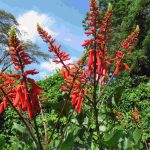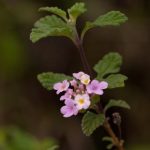TREE LIFE
MARCH 2023
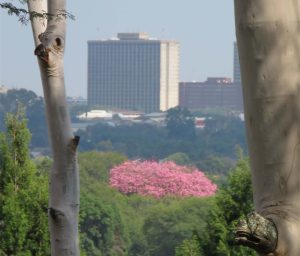
View of Harare from Hillside. Photo by Rob Jarvis.
Above you can see the sort of tree that our Chairman, Tony Alegria is suggesting on page 3 that each and every one of us is capable of investigating and turning into an interesting story for Tree Life to replace the Tree of the Month series. Maybe from where you sit there is something special to share with us all! This photo was taken by me from a deck in Hillside looking towards the city centre. Get writing!
National Botanical Garden 4th February 2023
By Tony Alegria
Only seven of us turned out on a cloudy morning to enjoy the task of trying to identify the less common acacias. A member we hadn’t seen for some time, Fay Robertson joined the other ladies, Meg Coates Palgrave and Dawn Siemers along with the guys – Mark Hyde, Jan van Bel, Jim Dryburgh and myself.
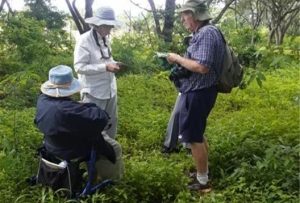
Serious discussion. Photo by Tony Alegria.
Meg had prepared a “Key to the tree species of Senegalia” to help us – each of us received a copy. The problem is that a botanical garden does not only have indigenous trees but has them from anywhere in the world! Keys are very useful but at times give us the incorrect answer as sometimes the two answers both fit the description. Trees just don’t read the books and do what they are supposed to do! If they are meant to have under six leaflets, more often than not they do have fewer but sometimes they may have six or seven thus leading to confusion!
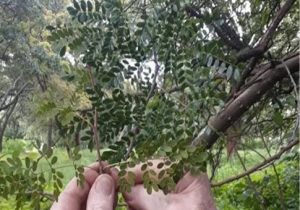
Top leaves shiny, lower ones not. Photo by Tony Alegria.
And so it was with a few trees that were all growing close to each other and looked similar with one having a label – Acacia welwitschii. So presumably they were all the same species. Like some other Acacias with hooked thorns, these trees also had a few knob thorns.
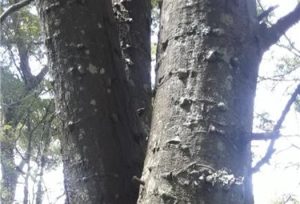
Knob thorns or smooth bark. Photo by Tony Alegria.
They all had small, hooked thorns, some had shiny leaves whilst others didn’t, leaflet shape appeared to be the same with a gap between them, but the size of the leaf varied a fair amount. So were they Acacia burkei, Acacia welwitschii or something else? We still don’t know!
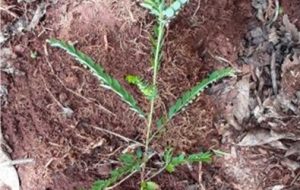
Phyllanthus leucanthus. Photo by Tony Alegria.
Before we arrived at the Acacia section we looked down – at a couple of fascinating weeds! One was a Phyllanthus leucanthus (right) Photo Tony Alegria
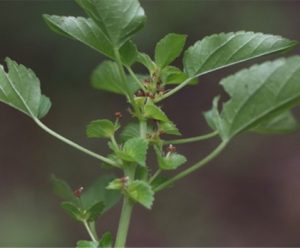
A species of Acalypha. Photo by Mark Hyde.
And the other was an Acalypha sp. Photo by Mark Hyde See left.
Tree of the Month
By Tony Alegria
Ryan Truscott has written many interesting Tree of the Month articles and unfortunately now has become too busy to continue writing them. I also think that after writing so many articles, he would have run out of trees he would like to write about. Grateful thanks Ryan for all the articles you have presented in so many Tree Lifes.
Now, we need to replace these Tree of the Month articles with something else and I think Street Trees are the answer. I am aware that there are members who shun exotic trees however whether you like it or not they are all over the place – in gardens and lining some streets. I really think we ought to get to know them as in the past they were specially imported by our city fathers to be planted as street trees and wherever else. There are also many exotic trees and plants that were brought into the country by immigrants to remind them of their home.
In some suburbs, street trees were planted so that the whole street or part of it would be a blaze of colour when they flowered. Trees with purple, yellow, white or orange flowers are the norm, but then you also get multi-coloured flowers e.g. Bau-hinias.
When we went through school, I’m sure we all had to write Compositions or Essays for the English Teacher which means that every one of us is quite capable of writing a story. Of course, writing about a tree is not quite the same thing, but all the information needed for any tree can be found on the internet. And if you think that your English is not very good, no problem, it can always be fixed – we just want the story! So, how do you go about it?
The first thing to do is to choose a tree that interests you. One that you really want to know about and then the information you find can be shared with all the other members. You need information!
Find the botanical name of the tree along with any synonyms and old botanical names, and also, if possible, what the names mean. Also the English common names.
Where is the natural habitat of the tree – it could be a whole area encompassing many countries or could be endemic to one country. Where is it grown around the world? Many countries or just a few? Sometimes some trees are so widely spread, no one really knows where they originated from.
Brief description of the tree – size, leaves, fruit, flowers etc. Shape and size of thorns, if any.
Uses of the tree – food, shade, ornamental, medicinal and what parts are used e.g. leaves, fruit or bark.
Where they can be seen, in which road in which suburb.
Any other information you can find that you think is interesting –e.g. a sacred tree (and why). If it’s interesting to you, you can bet it will be interesting to many others.
Now that you have the information, it’s a case of putting it down into a format which basically follows the acquisition of information as in the sequence above. Now a photo or two is great. Take photos if you can and if you can’t, that’s not a problem as we can source whatever is required from the internet and credit the photographers or websites as required.
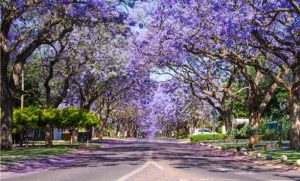
Jacarandas in Harare; photographer unknown.
We really want to have many articles at hand so we never end up with a very thin Tree Life! Everyone is capable of writing about a Street Tree so select a tree you would like to write about. Then let me know and I’ll tell you if someone else has chosen this tree or not – this will be on a first-come, first-served basis, we don’t want more than one person writing about the same tree. I will let all our members know who is writing about what tree via the Tree Society WhatsApp Group
Once you have written an article, don’t be in a rush to submit it. Have a look at it a couple of days later and you will be surprised at how often you will make changes or add more information.
However, let’s not be limited to only Street Trees, you can also write about an exotic tree in your garden or somebody else’s garden or you can write about any indigenous tree. And if you happen to know any interesting tree story, let us have it!
The editor can slot any article into Tree Life. We want to swamp the editor with articles! So please start doing something now!
Outing to Dandaro, Sunday 19th February 2023
By Tony Alegria
We decided to have a morning outing to have a look at the trees growing between the Dandaro Complex and the Borrowdale Road. To this end, we invited the Dandaro residents who are members of the Tree Society of Zimbabwe to participate and bring their friends along. The event was also advertised within the complex through Gail Hartman and three ladies joined the group along with two of our resident members.

Tree Society and Dandaro residents: photographer unknown.
The Dandaro five were joined by another nine of us along with Arthur Mavhimba of Wildaid. So we had a group of fifteen altogether which is pretty good considering the weather at this point in time. Saturday was an, it’s raining then it isn’t, then it is all day long and on Sunday it started the same way! Fortunately, before we began botanizing the rain stopped – the sky cleared and it warmed up. No more rain for the morning!
Mark Hyde was our leader and he had done some homework, so he knew exactly what was there – that is, everything except for the one misstree tree of which there were three – they may be Zanha golungensis. Mark had done his homework well and had all sorts of interesting titbits to add to whatever we were looking at. The first tree we looked at was a Rauvolfia caffra of which there were quite a few. Along the way we looked at two herbaceous plants, one was an indigenous lantana which had no prickles and the other was also an indigenous plant: –
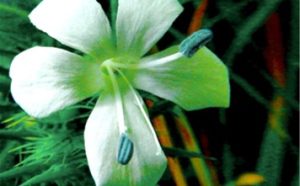
Barleria elegans with blue anthers. Photo by Jim Dryburgh.
Barleria elegans which surprisingly had blue pollen!
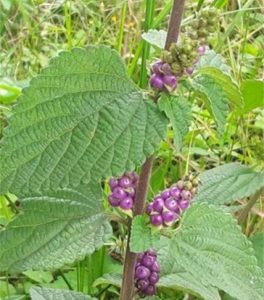
Lantana sp. (not camara). Photo by Tony Alegria.
I’m told that Tom Muller had planted these trees before building commenced in Dandaro and many of these trees looked mature. There were some surprises e.g. Albizia glaberrima and then some very young Albizias gummifera – presumably their parent had died. We also looked at what could be a Fraxinus velutina. Velvet ash which was laden with fruit but rather different to the Fraxinus americana or Fraxinus pennsylvanica as it had rather narrow leaflets. After over one and a half hours we stopped botanizing as none of us are getting younger and the day was now on the hot side. Thanks to the Dandaro residents for coming along and a big thank you to Mark who made this one of the more enjoyable outings of late.
Some of the other trees seen that are not mentioned above: Spathodea campanulata. African flame tree; Khaya anthotheca. Red mahogany; Ficus lutea. Large-leaved fig; Anthocleista grandiflora. Tobacco leaf; Acacia abyssinica. Nyanga flat-top; Chionanthus battiscombei. Water pock-ironwood; Fraxinus velutina. Velvet ash; Radermachera sinica. China doll; Bauhinia galpinii. Red bauhinia; Casuarina cunninghamiana. Beef wood; Toona ciliata. Cedrela; Trichilia dregeana. Forest natal-mahogany; Delonix regia. Flamboyant; Erythrina lysistemon. Sacred coral-tree; Fernandoa abbreviata. Fernandoa; Brachychiton discolor. Lacebark tree and Acacia sieberiana. Paperbark thorn.
The strangest, unexpected thing about this venue was the traffic noise coming from the Borrowdale Road. I’d hate to be there when the road is busy!
A Giant Has Fallen
by Rob Jarvis
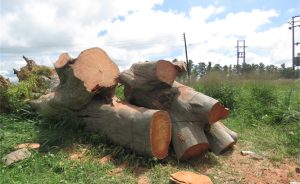
The fallen Giant. Photo by Rob Jarvis.
Here at ART Farm on the outskirts of Harare, we are fortunate to work and live on a very productive and interesting piece of land known commonly as ART Farm. It is split into two different agro-ecological areas, almost exactly 50:50 between natural vleis or wetlands and then the farming and research cropping areas which are red clay loam soils, very fertile and have been managed extremely well for more than 40 years. There are a few hectares of miombo woodland on the northern end facing down to Mazowe dam. These have been severely stressed by rampant tree cutting.

The Gwebi River. Photo by Rob Jarvis.
Various owners over the years have attempted to try and drain the wetlands using the commonly accepted practice of planting gums or eucalypts and poplars, in various places. The good rainy season we have experienced to date has shown that this has not been very successful. The soil profile is fully charged, the vleis are running and the Gwebi river that runs through the southern end of the property is going great guns. The water is crystal clear and fresh-looking. It doesn’t come into our jurisdiction like that. When you cross it on Alpes Road, just after the Halsteads/Union Hardware intersection with Harare Drive, the river is choked with weeds, the water is frothy with deter-gent and industrial waste and it often dams up and spills dangerously over the low bridge.
However winding through about a kilometre and a half of natural wetland habitat, affected only occasionally by cattle grazing, the water is fully purified. Some of the early gums planted have reached their maturity and they have started dying off and about three weeks ago a long-dead one fell and crashed into a farm reservoir. It has hardly any root system and it is surprising that a gum of such immense girth and height at its heyday could have been held up for decades. Anyway, we had no choice but to bring in the chainsaws and cut it into manageable pieces. We found a man with a longer blade who has been able to cut the main bole into four usable table tops. The cut main branches we shall use as seats and small tables when we have functions at ART. The smaller branches have of course gone for firewood.
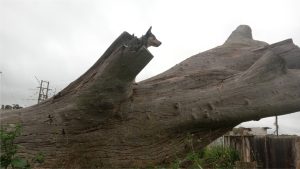
Zambezi Blue on the fallen tree. Photo by Rob Jarvis.
Our blue heeler, known as Zambezi-Blue, just found the fallen giant exactly what he was looking for in the early morning to burn off some energy. He is naturally a bit peeved that the giant has been all cut up. In a future issue of Tree Life, I’ll show you how the gum pieces will work for us as robust outdoor furniture.
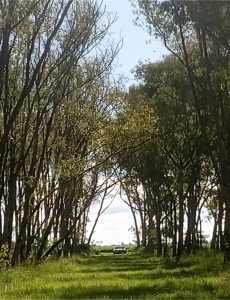
Gum plantation on Art Farm. Photo by Rob Jarvis.
Not exactly a city street view but nevertheless this gum plantation may be of interest. It is on ART Farm and is likely Eucalyptus camaldulensis. Although the gums look huge in comparison to the vehicle in this photograph, they are actually quite small and because they are growing directly in a very poorly drained vlei, they are twiggy and rather poor relatives of the gums you would find in habitat in Australia. The plantation was actually planted by the Forestry Commission but for the last two decades, there has been virtually no interest in their welfare.
TREE SOCIETY COMMITTEE AND CONTACTS
Chairman Tony Alegria tonyalegria47@gmail.com 0772 438 697
Vice Chairman Rob Jarvis bo.hoom52@yahoo.com 0783 383 214
Honorary Treasurer Bill Clarke wrc@mweb.co.zw 0772 252 720
Committee member Jan van Bel jan_vanbel@yahoo.com 0772 440 287
Venue Organiser Ann Sinclair jimandannsincs@zol.co.zw 0772 433 125
Committee member Ryan Truscott ryan.kerr.truscott@gmail.com 0772 354 144
Secretary Teig Howson teig.howson@gmail.com 0772 256 364
Tree Society Website https://treesociety.org.zw/
Tree Society Facebook https://www.facebook.com/groups/ztreesociety/
Flora of Zimbabwe: https://www.zimbabweflora.co.zw/
Flora of Tropical Africa: https://plants.jstor.org/collection/FLOTA


